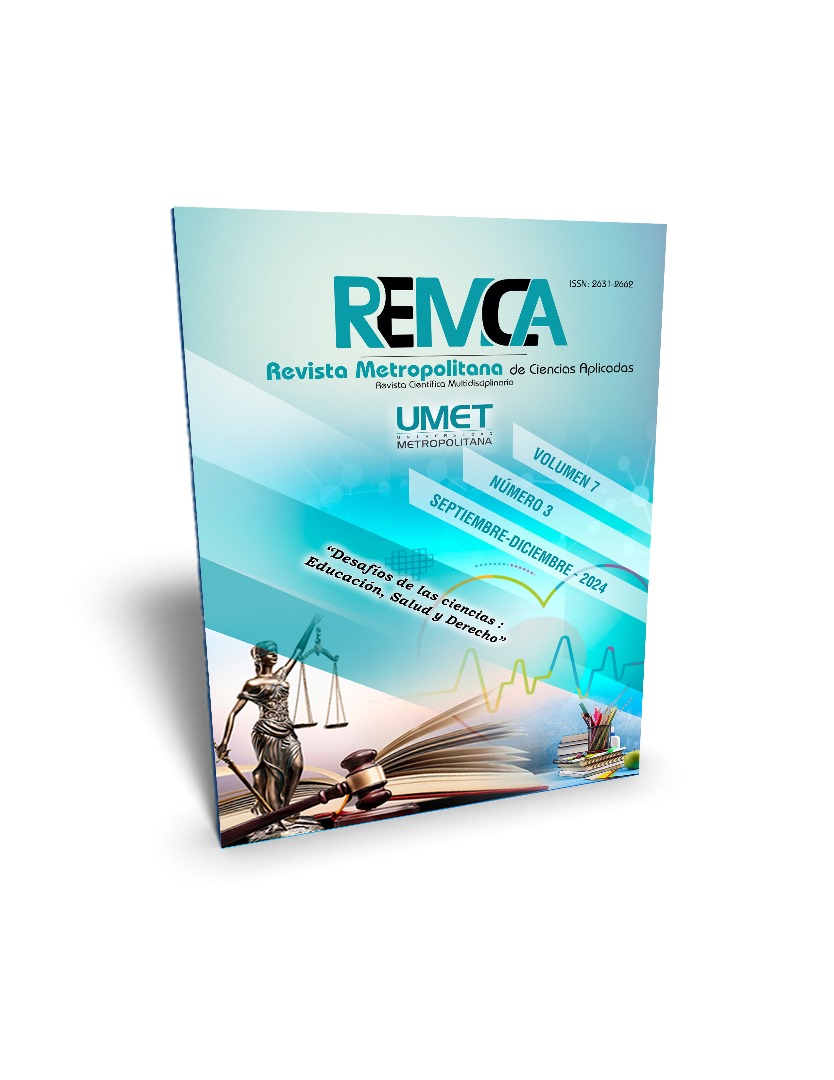Forensic ballistics and its evidentiary contribution in criminal investigation
DOI:
https://doi.org/10.62452/c2dcw084Keywords:
Forensic Ballistics, criminal investigation, projectiles, weapons, cartridgesAbstract
The study of firearms, their classifications, parts, components, ammunition, lethality, among other aspects of forensic ballistics, plays a fundamental role in the fight against crime, especially against terrorism and organized crime. The objective of this essay is to expose the theoretical and conceptual elements in the investigation process of crimes in which the presence of a firearm is verified or its use is suspected, particulars that have been developed through the specialty. of ballistics and that require the domain of professionals who intervene in criminal proceedings. The investigation of crimes in which firearms are used in Ecuador has become a priority due to the increase in violence between the years 2020 and 2024, from which the theoretical results achieved are considered part of the fight against crime. Theoretical research methods such as analysis and synthesis, induction, deduction, from the abstract to the concrete and from the concrete to the abstract, among others, were used in the study. Finally, training based on the topics addressed is suggested to police investigators, experts, forensic doctors and other members of the “Comprehensive Specialized System of Investigation, Legal Medicine and Forensic Sciences”.
Downloads
References
Alarcón Flores, L. A. (2019). Balística Forense. https://criminalisticaencolombia.files.wordpress.com/2010/11/balistica-forense-luis-alfredo-alarcon-flores2.pdf
Araúz, D. (2020). Planimetría Forense y su eficacia para fijar indicios, Instituto de Medicina Legal y Ciencias Forenses, Chiriquí. Revista Científica de la Universidad Especializada de las Américas (REDES), 1(12). https://revistas.udelas.ac.pa/index.php/redes/article/download/105/154/281
Brito Febles, O. (1999). Manual de Criminalística. UCLV.
Cuero Castañeda, I., Pardo Díaz, F. A., & Bonilla Fernández, L. T. (2018). El estudio de los elementos materiales de prueba como instrumento para el esclarecimiento del crimen: un análisis desde la técnica de la balística. (Trabajo de titulación). Universidad La Gran Colombia.
De León Palomo, O. A., & Guerrero Abundis, R. (2014). Procedimiento Criminalístico al Encontrar un Arma de Fuego en la Escena del Crimen. https://criminociencia.com/procedimiento-criminalistico-al-encontrar-un-arma-de-fuego-en-la-escena-del-crimen/
Ecuador. Asamblea Nacional. (2014). Código Orgánico Integral Penal. Registro Oficial 222. https://www.defensa.gob.ec/wp-content/uploads/downloads/2021/03/COIP_act_feb-2021.pdf
Fernández Pereira, J. (1991). Teoría General, Técnica, Táctica y Metodología Criminalísticas. Universidad de La Habana.
Fierro Méndez, H. (2006). Introducción a la Criminalística. Leyer.
García Macías, Z. I. (2020). El procesamiento del lugar de los hechos con indicios balísticos. Estudios Forenses. Revista Electrónica del Instituto Jaliscience de Cincias Forenses, 1(1).
González Moreno, L. R. (1998). Balística Forense. Porrúa.
Hernández de la Torre, R. (2002). La Ciencia Criminalística. https://www.studocu.com/co/document/universidad-pedagogica-y-tecnologica-de-colombia/derecho-penal-especial-ii/la-ciencia-criminalistica-by-hernandez-de-la-torre-z-lib/56938111
Hernández de la Torre, R. (2019). Curso de Postgrado. “La Ciencia Criminalística”. ICITAP.
Jíménez Ortiz, J. (2011). Balística Forense: Inicios. Revista de Criminología y Ciencias Forenses, (12), 6-11. https://dialnet.unirioja.es/descarga/articulo/3583881.pdf
Lazzaroni, A. (2023). Calibres y Cartuchos-el C+C de la Balística. https://reconciliandomundos.com.ar/calibres-y-cartuchos-el-c-c-de-la-balistica/
Locles, R. J. (2006). Balística y Pericia. La Rocca.
Luis de Santos, A. (2023). ¿Ánima lisa o estriada? Así funcionan los cañones de los principales carros de combate del mundo. https://www.larazon.es/tecnologia/anima-lisa-estriada-asi-funcionan-canones-principales-carros-combate-mundo_2023022663fb88a3bbe58a000153199a.html
Nicaragua. Peritos Balísticos Laboratorio de Criminalística. (2013). Manual de Balística Forense. https://gc.scalahed.com/recursos/files/r161r/w25335w/6.pdf
Organización de las Naciones Unidas. (2020). Fundamentos sobre las armas de fuego y municiones. https://www.unodc.org/documents/e4j/Firearms/E4J_Firearms_Module_02_-_Basics_on_Firearms_and_Ammunition_ES_final.pdf
Olivo Cerda, F. P. (2023). Impacto de las pruebas balísticas en la investigaciónde muertes violentas. Revista Imaginario Social, 6, 121-133. https://www.revista-imaginariosocial.com/index.php/es/article/view/109
Romero Anturi, L. E., Norvey Zambrano , J., & Espinosa Blanco, N. E. (2014). Distancia de disparo y su interpretación frente a la conducción de hostilidades en el conflicto. Revista Científica General José María Córdova, 12(13), 291-320. https://revistacientificaesmic.com/index.php/esmic/article/view/164
Ruiz Moreno, M. (2008). Balística: Teoría y Práctica. Temis S.A.
Sanler Castillo, M. (2018). Criminalística para abogados. https://es.scribd.com/document/313087925/criminalistica-para-abogados
Santamaría Ávila, M. C., Rocha Rodriguez, E. A., & Valencia Betancur, O. D. (2015). La balistica en la investigación criminal para el esclarecimiento de homicidios. (Diplomado de investigación). Universidad La Gran Colombia:
Silveira, C. (2021). Munición. https://es.scribd.com/document/498386859/Municiones
Downloads
Published
Issue
Section
License
Copyright (c) 2024 Cinthia Jamileth Cabrera-Peralta, Sebastián Lorenzo Orellana-Muñoz, Armando Rogelio Duran-Campo (Autor/a)

This work is licensed under a Creative Commons Attribution-NonCommercial-ShareAlike 4.0 International License.
Authors who publish in Revista Metropolitana de Ciencias Aplicadas (REMCA), agree to the following terms:
1. Copyright
Authors retain unrestricted copyright to their work. Authors grant the journal the right of first publication. To this end, they assign the journal non-exclusive exploitation rights (reproduction, distribution, public communication, and transformation). Authors may enter into additional agreements for the non-exclusive distribution of the version of the work published in the journal, provided that acknowledgment of its initial publication in this journal is given.
© The authors.
2. License
The articles are published in the journal under the Creative Commons Attribution-NonCommercial-ShareAlike 4.0 International License (CC BY-NC-SA 4.0). The terms can be found at: https://creativecommons.org/licenses/by-nc-sa/4.0/deed.en
This license allows:
- Sharing: Copying and redistributing the material in any medium or format.
- Adapting: Remixing, transforming, and building upon the material.
Under the following terms:
- Attribution: You must give appropriate credit, provide a link to the license, and indicate if any changes were made. You may do this in any reasonable manner, but not in any way that suggests the licensor endorses or sponsors your use.
- NonCommercial: You may not use the material for commercial purposes.
- ShareAlike: If you remix, transform, or build upon the material, you must distribute your creation under the same license as the original work.
There are no additional restrictions. You may not apply legal terms or technological measures that legally restrict others from doing anything the license permits.




